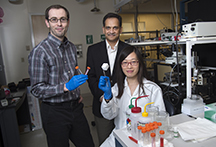April 4, 2016
New environmental cleanup technology rids oil from water
 |
|
Purdue University researchers have developed a technology for removing oils and other pollutants from water by modifying commercially available melamine sponges, representing a potential tool for environmental cleanup. From left are research assistant professor of mechanical engineering Justin A. Weibel, Suresh Garimella, executive vice president for research and partnerships and the Goodson Distinguished Professor of Mechanical Engineering, and postdoctoral research associate Xuemei Chen. (Purdue University photo/Mark Simons) |
WEST LAFAYETTE, Ind. – A new technology that is easy to manufacture and uses commercially available materials makes it possible to continuously remove oils and other pollutants from water, representing a potential tool for environmental cleanup.
The material is shown to be superhydrophobic and superoleophilic, meaning it rejects water while absorbing oils. It is made using melamine sponges, an ultra-low-weight, porous material found in various products including household cleaning pads and insulation materials. The researchers modified the melamine sponge by dipping it into a solution containing a small amount of silicone rubber called PDMS and the solvent hexane, resulting in an extremely thin coating that repels water while allowing oil to be absorbed into the sponge.
"The reason we're excited about this is that it is manufactured using a very inexpensive one-step process to coat the melamine sponges, and the material can be reused many times," said Suresh V. Garimella, Purdue University's executive vice president for research and partnerships and the Goodson Distinguished Professor of Mechanical Engineering. "We believe this can be readily adopted for the cleanup of oil spills and industrial chemical leaks."
Findings are detailed in a paper that appeared online in March in the American Chemical Society's journal Industrial & Engineering Chemistry Research. The paper was authored by postdoctoral research associate Xuemei Chen, research assistant professor of mechanical engineering Justin A. Weibel and Garimella.
Chen made the discovery while working in the Birck Nanotechnology Center in Purdue's Discovery Park. The researchers have demonstrated that the new material can remove oils and organic chemical pollutants that are immiscible with water such as hydrocarbons, coolants and insulating fluid from electrical transformers, carcinogenic compounds called PCBs and certain pesticides.
"The target is any pollutant that is immiscible with water and that has a low surface tension," Weibel said.
By contrast, water has a high surface tension, causing it to be repelled by the sponge.
|
Water is contaminated with silicone oil (dyed red) and the newly developed sponge material is swept over the surface to absorb the oil layer; the oil-saturated sponge floats in the dish and can easily be picked up out of the clean water. (Purdue University photo/Justin Weibel) |
"You need this contrast in surface tension for the sponge material to remove the contaminant," Garimella said.
Other technologies under development that incorporate superhydrophobic and superoleophilic properties are either expensive, difficult to scale up, or require the use of exotic materials such as carbon nanotubes and graphene.
"Oil spillage from industrial sources has caused severe damage to the environment," Chen said. "The conventional methods used to clean up oils and organic pollutants are slow and energy-intensive. The development of absorbent materials with high selectivity for oils is of great ecological importance for removing pollutants from contaminated water sources."
Findings show the sponge material has an absorption capacity of 45-75 times its own weight, which is comparable to other more exotic materials under development.
"There are two ways to use this sponge," Garimella said. "You can just drag it over the surface of the water to absorb the contaminant or apply suction so that it continuously draws out the oil and leaves the water behind."
The researchers have filed a provisional U.S. patent application through the Purdue Research Foundation's Office of Technology Commercialization.
Writer: Emil Venere, 765-494-4709, venere@purdue.edu
Sources: Suresh Garimella, 765-494-6209, sureshg@purdue.edu
Justin A. Weibel, 765-494-4762, jaweibel@purdue.edu
Xuemei Chen, chen1497@purdue.edu
Note to Journalists: The research paper is available at http://pubs.acs.org/doi/abs/10.1021/acs.iecr.6b00234 or from Emil Venere, 765-494-4709, venere@purdue.edu
ABSTRACT
Continuous Oil−Water Separation Using Polydimethylsiloxane-Functionalized Melamine Sponge
Xuemei Chen, Justin A. Weibel, and Suresh V. Garimella*
School of Mechanical Engineering and Birck Nanotechnology Center, Purdue University,West Lafayette, Indiana 47907-2088, United States
*Corresponding Author E-mail: sureshg@purdue.edu
The development of absorbent materials with high selectivity for oils and organic solvents is of great ecological importance for removing pollutants from contaminated water sources. We have developed a facile solution-immersion process for creating polydimethylsiloxane (PDMS) -functionalized sponges for oil-water separation. Sponge materials with densities ranging from 8 to 26 mg/cm3 were investigated as candidate skeletons. After functionalization, the lowest-density melamine sponge exhibits superior superhydrophobic and superoleophilic properties, absorption capacity, oil-water selectivity, and absorption recyclability. Via suction through such a functionalized sponge, we have experimentally demonstrated that various kinds of oils can be continuously separated from immiscible liquid mixtures without any water uptake. The widely available raw materials (melamine sponge and PDMS solution) and simple synthesis steps yield a cost-effective and scalable process for fabrication of absorbent materials that can be readily adopted for the cleanup of oil spills and industrial chemical leakage of low-surface-tension solvents that are immiscible with water.

